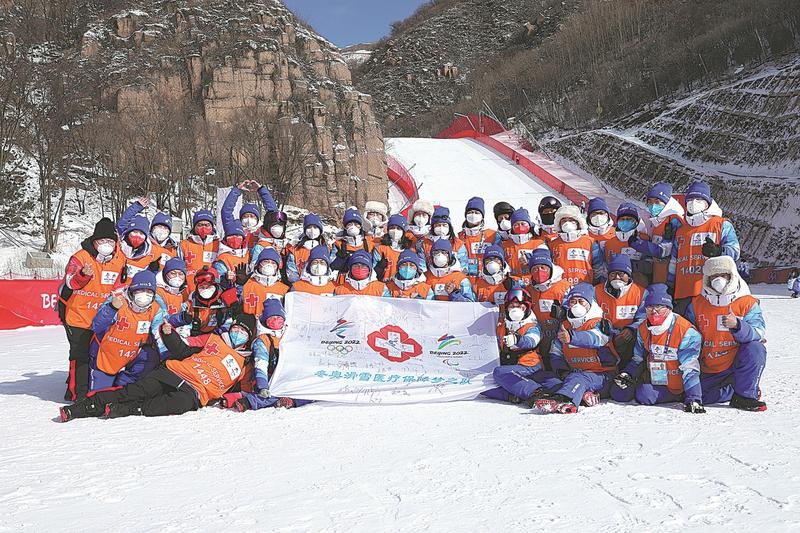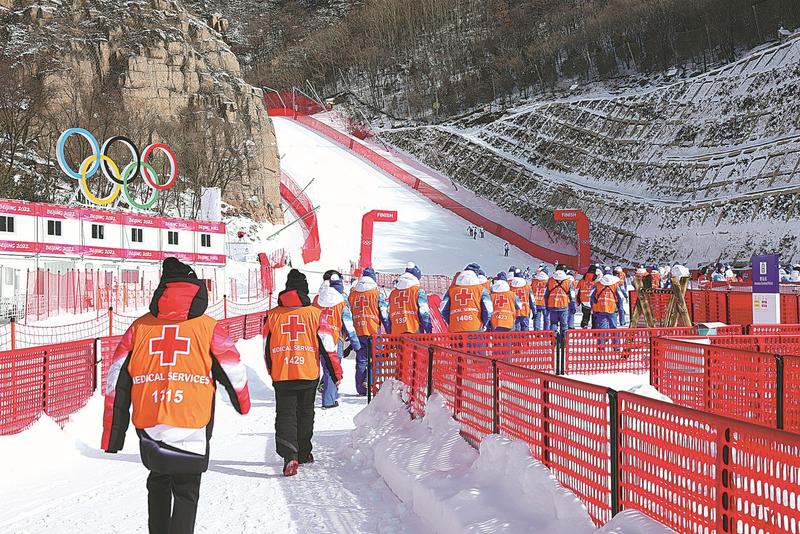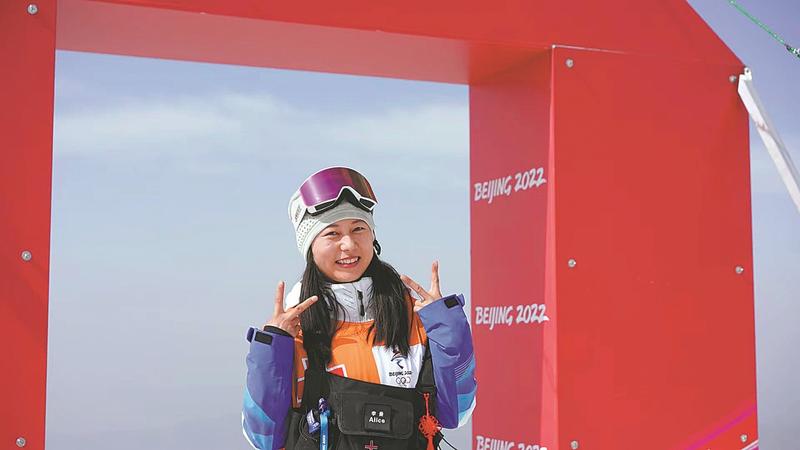 In this undated photo, a total of 38 Chinese rescue staff are on duty at the National Alpine Skiing Centre in Yanqing district during the Beijing Paralympic Winter Games. Dubbed "ski doctors", they aim to reach an injured athlete within four minutes, but often arrive sooner. (PHOTO PROVIDED TO CHINA DAILY)
In this undated photo, a total of 38 Chinese rescue staff are on duty at the National Alpine Skiing Centre in Yanqing district during the Beijing Paralympic Winter Games. Dubbed "ski doctors", they aim to reach an injured athlete within four minutes, but often arrive sooner. (PHOTO PROVIDED TO CHINA DAILY)
For almost a month, the diminutive Li Man has been working at an altitude of over 2,000 meters, tirelessly carrying a medical rescue kit on her back that weighs up to 15 kilograms.
As one of the 38 Chinese rescue staff on duty to protect the para athletes at the National Alpine Skiing Centre in Yanqing district during the Beijing Winter Paralympics Games, Li and her team members call themselves the "ski doctors".
"We come from different hospitals and departments, such as anesthesiology, orthopedics, emergency room, internal medicine, and stomatology, to ensure rescue work is as comprehensive as possible," said Li, who comes from the China Rehabilitation Research Center in Beijing. She has remained in Yanqing district since January.
With competitors capable of hitting top speeds of up to 100 kilometers per hour, para Alpine skiing is a precarious sport. The risk factor increases on the challenging slopes at the National Alpine Skiing Centre, where the longest downhill course starts at an altitude of 2,179 meters, has a drop of about 900 meters, and a maximum slope gradient of 68 degrees.
The rescue team-the first of its kind on snow in China-was established in 2018. During the Paralympics it is operating as an all-Chinese team
The rescue team-the first of its kind on snow in China-was established in 2018. During the Paralympics it is operating as an all-Chinese team.
"During the Winter Olympic Games, we hired 12 international ski doctors-because previously there were no ski rescue medical staff in China, and the International Ski Federation was not totally sure how we would perform," Li said.
"But after we proved our abilities, the Paralympics are being served by the Chinese team alone," she added.
Qualifying as a ski doctor requires a diverse range of skills-combining medical knowledge, English-language proficiency and, of course, skiing ability.
"Since 2018, we've visited a resort for ski training for around a month each year to ensure that we could reach the injured people as fast and as safely as possible," said Li.
 In this undated photo, a total of 38 Chinese rescue staff are on duty at the National Alpine Skiing Centre in Yanqing district during the Beijing Paralympic Winter Games. Dubbed "ski doctors", they aim to reach an injured athlete within four minutes, but often arrive sooner. (PHOTO PROVIDED TO CHINA DAILY)
In this undated photo, a total of 38 Chinese rescue staff are on duty at the National Alpine Skiing Centre in Yanqing district during the Beijing Paralympic Winter Games. Dubbed "ski doctors", they aim to reach an injured athlete within four minutes, but often arrive sooner. (PHOTO PROVIDED TO CHINA DAILY)
Ski doctors are required to reach an injured person within four minutes, but in fact, often arrive within one minute
Ski doctors are required to reach an injured person within four minutes, but in fact, often arrive within one minute.
Li added that they have been given professional training for first aid, and online and offline English training to ensure that they can communicate smoothly with foreign athletes and staff in international events.
"Because our work environment is not based in a hospital or a medical station, all our rescue equipment and supplies must be carried with us," Li said.
Their first-aid kits contain oxygen cylinders, tracheal intubators, materials to fix fractures, and so forth-combining to weigh about 15 kilograms.
"I remembered that when I first carried the bag on my back, I fell on the snow course and almost rolled all the way down the hill, but now I can ski with the first-aid kit on my back for several kilometers to rescue people," she said.
The ski doctors have also received specialized training for the Paralympics.
"We hired the coach of the national team to train us on the disassembly and removal of the equipment used by para skiers before the Winter Paralympics, to make sure that it could be quickly removed to protect the athletes from secondary injury," Li explained.
ALSO READ: Setting the stage for success
Waking up at 5:30 am every day and carrying out numerous rescues and training drills, Li has been kept plenty busy over the last three months. And every time she sees an athlete crash on the course, it doesn't get any less stressful.
"We saw a lot of athletes fall on the courses during the Winter Olympic Games and the Paralympics. We are very worried each time because we can't instantly spring into action. We need to wait for the all-clear from the control center to confirm there are no other athletes on the course and no other potential dangers. So, every time I get the official go-ahead, I can't wait to rush to the athletes."
According to Li, the age of the ski doctors ranges from 20 to over 60.
 In this undated photo, a total of 38 Chinese rescue staff are on duty at the National Alpine Skiing Centre in Yanqing district during the Beijing Paralympic Winter Games. Dubbed "ski doctors", they aim to reach an injured athlete within four minutes, but often arrive sooner. (PHOTO PROVIDED TO CHINA DAILY)
In this undated photo, a total of 38 Chinese rescue staff are on duty at the National Alpine Skiing Centre in Yanqing district during the Beijing Paralympic Winter Games. Dubbed "ski doctors", they aim to reach an injured athlete within four minutes, but often arrive sooner. (PHOTO PROVIDED TO CHINA DAILY)
One thing they all have in common, though, is that they have been away from their families for a long time, including the Chinese Lunar New Year, due to the closed-loop system to prevent the spread of COVID-19.
READ MORE: Beijing 2022 Paralympics aims to promote 'accessibility mindset'
"There were a lot of things going on in different families during this period, including the death of loved ones and the birth of babies, that we couldn't participate in personally," Li said.
"There are definitely pities, but no regrets, because we have prepared well before entering the closed loop, for the sake of the competitions and the prevention of the pandemic. We have no complaints," Li said.
She hopes that China's ski medical rescue system will continue to grow and more recruits will join.
"I also hope that we don't need to invite international ski doctors when holding large international tournaments in the future," she said. "And that our Chinese ski doctors can be invited to support events in other countries."


